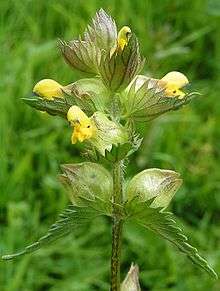Rhinanthus minor
| Yellow rattle, cockscomb | |
|---|---|
 | |
| Scientific classification | |
| Kingdom: | Plantae |
| (unranked): | Angiosperms |
| (unranked): | Eudicots |
| (unranked): | Asterids |
| Order: | Lamiales |
| Family: | Orobanchaceae |
| Genus: | Rhinanthus |
| Species: | R. minor |
| Binomial name | |
| Rhinanthus minor L. | |
Rhinanthus minor, the yellow rattle, little yellow rattle[1] or cockscomb, is a flowering plant in the genus Rhinanthus in the family Orobanchaceae, native to Europe, northern North America, and Western Asia.


It is a hemi-parasitic herbaceous annual plant that gains some of its nutrients from the roots of neighbouring plants. It grows to 25–50 cm tall, with opposite, simple leaves, with a serrated margin. The flowers are yellow, produced on a terminal raceme. The fruit is a dry capsule, which contain loose, rattling seeds when ripe; the plant's name refers to these. Its preferred habitat is dry fields or meadows, where its flowering period is between June and September. The plant can associate with many different host species, notably Poaceae (grasses) and Fabaceae (legumes).[2]
In Ireland and Scotland, this species is often associated with Machair habitat. Research at the UK's Centre for Ecology and Hydrology has shown that encouraging yellow rattle to grow in hay meadows greatly increases biodiversity by restricting grass growth and thereby allowing other species to thrive. The seeds are spread very effectively by traditional hay-making practices.
It can be cultivated by scarifying the surface of the ground with a fork or similar, then sowing onto short grass, 0.5–1 gram of seed per square metre. Yellow rattle seed is short-lived and should always be sown in the autumn, using seed harvested that year. Then, keep grass short for beginning of March when seedlings establish. Thereafter, the grass should not be cut until the end of July to allow the yellow rattle to flower and go to seed, then cut short.
Etymology
Rhinanthus is derived from Greek and means 'nose flower', which is in reference to the shape of the upper lip of the corolla. Minor means 'smaller'.[3]
References
- ↑ "Rhinanthus minor". Natural Resources Conservation Service PLANTS Database. USDA. Retrieved 21 October 2015.
- ↑ Gibson, C.C. & Watkinson, A.R. Oecologia (1989) 78: 401. doi:10.1007/BF00379116
- ↑ Gledhill, David (2008). "The Names of Plants". Cambridge University Press. ISBN 9780521866453 (hardback), ISBN 9780521685535 (paperback). pp 260, 330
Westbury, D.B. (2004) Rhinanthus minor L. Journal of Ecology, 92, 906-927.